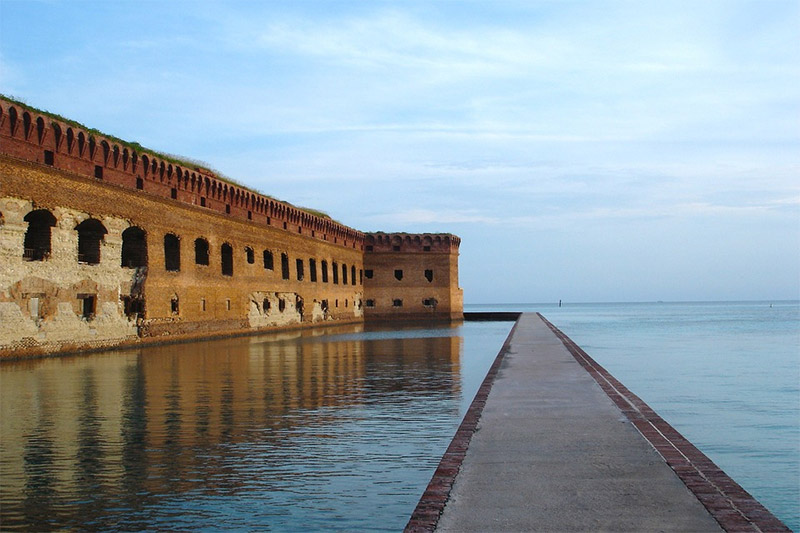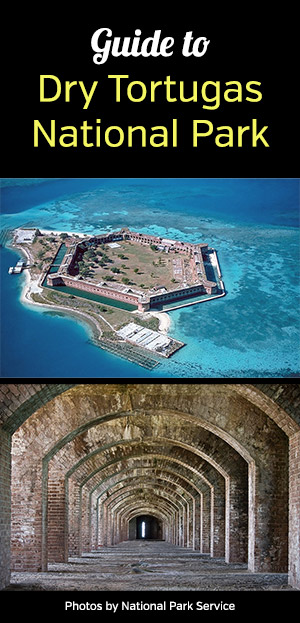
Photo by National Park Service / Public Domain
Although Dry Tortugas may not be the first national park that comes to mind, it is definitely one of the most unique. Located in the Gulf of Mexico, about 70 miles west of Key West, Dry Tortugas is known for amazing sea life, beautiful birds, pristine coral reefs, and crystal blue waters. Fort Jefferson is the main attraction of this 100-square mile park, which also includes the seven Dry Tortugas islands.
If you don’t enjoy fighting the crowds at the most popular national parks you’ll be pleased to know that only about 60,000 people visit Dry Tortugas each year (that averages out to less than 200 people per day)!
Why do so few people visit this beautiful national park? Well, it’s not the easiest to access. You can only reach the park by boat or seaplane. We’ll look at all of the details related to visiting at the end of this article.
What’s the Meaning of the Name
The Dry Tortugas islands are called “dry” because there is no fresh surface water on the islands. “Tortugas” is Spanish for “turtles”. The explorer Ponce de Leon caught many seas turtles here, and he called the islands the “tortugas”.
Fort Jefferson

Fort Jefferson by 12019 / CC0
Fort Jefferson is a 19th century fort, and it is the largest brick masonry structure in the Western Hemisphere. You can tour the fort and photograph it, along with its beautiful surroundings. Construction on the fort began after the U.S. purchased Florida from Spain, but the construction was never fully completed. Completed or not, it’s still a very unique and interesting setting for photographing. At one point in time the fort served as a prison.
Photographing Dry Tortugas National Park
If your primary purpose of visiting is to photograph the park, there are a few main points of interest. First, Fort Jefferson as the centerpiece of the park is obviously an area of interest.

Photo by NPS / CC BY 2.0
Wildlife is also a great subject for photographing at Dry Tortugas. There are almost 300 species of birds that can be seen here, although only a few nest in the park. If you want to see and photograph birds, the spring is a great time to visit. The best time to see migratory birds that pass through the park is usually in April.
Snorkeling is a popular activity, and if you bring some underwater gear you can capture great photos of fish and sea life. Scuba diving is also popular, especially in the area of a few shipwrecks.

Photo by John Dengler / CC BY 2.0
Sunrise and sunset are great times in general for photography, and Dry Tortugas is no exception. If you’re able to stay overnight and camp in the park, it will give you an opportunity to capture some beautiful photos of a scene that most daily visitors don’t get to experience.
Staying overnight will also give you the opportunity to see and photograph the night sky. The remote location means that you’ll have very little light pollution, and on a clear night you’ll have an amazing sky to photograph.
Visiting Dry Tortugas National Park
The easiest way to visit is by ferry. The ferry leaves daily from Key West and the ride takes about 2 hours each way. If you visit just for the day you’ll have about 4-5 hours at the park. Visit this page for details on the ferry.
In addition to the ferry, you can also take a private or charter boat. If you’re bringing your own boat you’ll need a permit. If you’re interested in a charter you can get some additional information from the National Park Service website, but taking the ferry is the most convenient, and generally the cheapest, way to visit.
The other option, which is obviously more costly, is to take a seaplane. For information on flights please visit this website.
While a day trip by ferry is pretty convenient for visiting, it doesn’t give you much time to enjoy and photograph the park (it’s enough time for most visitors, but not so convenient for photographers). Not to mention, your stay will cover the middle of the day. So if you want to photograph a sunrise or sunset you’ll need to stay overnight.
Camping is allowed at the Garden Key campground, which is just south of Fort Jefferson. The availability is extremely limited, so plan ahead. Camping is limited to guests arriving by ferry, so if you want to stay overnight that makes your decision about transportation even easier! Only 10 campers per day are allowed on the ferry.
If you decide to stay overnight you’ll be able to enjoy a national park with very few people around. You’ll be able to photograph the sunset, a beautiful starry sky (if the conditions are ideal), and the sunrise. Be aware that this is primitive camping with no running water, so you’ll need to pack accordingly.
When to Visit
If you want to see and photograph birds, April and May are generally the best months.
Summer months are obviously the hottest, but they also usually bring calmer water. If you’re taking the ferry you may appreciate the smoother ride. And the calm water is also better for snorkeling and diving.
The fall brings cooler temperatures, but generally rougher waters.
Winter brings the coolest temperatures, but the water is rough and it’s often very windy.
Regardless of when you visit you should pay attention to the weather forecast. If you’re arriving by ferry you’ll have the advantage of knowing that the operators are also keeping an eye on the weather and safety.

Photo license links: CC0, CC BY 2.0